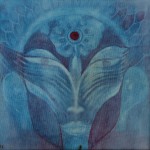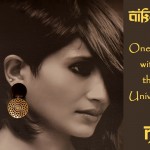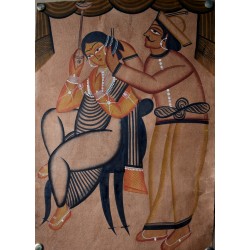Folk and Tribal Art of Bengal

Folk art has many forms in India but it is only in recent years that it has received its due attention. In a nation that comprises 35 states, each distinct cultural and traditional identity is displayed in the folk art of the region. Apart from this, each tribe also carries along with its traditions, art forms that are unique to them known as tribal art. The state of West Bengal was one of the first in the move towards recognizing and reviving its folk and tribal art traditions.

In fact, not one, but several forms of folk art originate from the Eastern region of India comprising West Bengal, Orissa and Bihar.
Santhals are the third largest tribe in India and are known for their unique form of tribal paintings known as Santhal Tribal Paintings. Santhal tribes are sustained by the forests and their occupations - farming, fishing, hunting - revolve around the forests that they live in. After a long day at work, they retire for the day and find relaxation in music and dance. The inherent love of dance and music forms an important part of Santhal fairs and festivals. Themes in Santhal paintings revolve around this community life especially celebrations and rituals. Paintings depict dancing, harvest and merry making through enchanting minimalist images in muted shades.
The paintings are drawn by a special community called Jadu Patuas or magic painters in the Santhal Paragana district of Bengal/Bihar borders. The painters are called magic painters because they paint to preserve the crops, avert diseases, honour the dead and so on. Chakshudaan Pata, for example, a painting made for a bereaving family, is shrouded in magic and mysticism. When somebody dies in a village, the Jadu Patua visits the family with an image representing the deceased, but the pupil’s in the eyes of the image are missing. After the family makes a gift offering or daan to the Jadu Patua, he then performs the Chakshudaan or “bestowal of sight” by painting of the iris in the blank eyes of the portrait in order to free the dead person’s soul and send it to heaven.
Almost a world apart are the Kalighat style of paintings which was born in the market places of Kolkata during the 19th century. It is said that Kalighat paintings originated in the vicinity of the Kalighat Kali Temple in Kolkata. Originally the art depicted Hindu gods and mythological characters and stories and was sold to visitors as souvenirs from the religious sanctuary. In later times, Kalighat paintings also depicted ordinary people and everyday life as well as social changes that were taking place at the time. Marked by generously curving figures of both men and women, the paintings acquired an essentially satirical style. The ‘babus’, as the 19th century, British influenced, nouveau rich Bengali gentlemen were called by the traditional people, were objects of fun not just for their unorthodox mannerisms but also for their often very tasteless and conspicuous consumption. Thus the “babu culture” portrayed in the Kalighat ‘patas’ often shows inversions of the social order like wives beating husbands or leading them about in the guise of pet dogs, maidservants wearing shoes, sahibs in undignified postures. Ironically, these satirical portrayals were created by artists who were and are rarely educated. Although largely secular, paintings of gods and goddesses continued in much the same de-romanticised way as the humans are.
Natsy by Design brings you these and other folk paintings from the East, including Madhubani and Patachitra traditions at http://natsybydesign.com/paintings/folk-art-from-east





7 Comment(s)
1
1
<ahref="https://disposablecartsuk.com/product/acapulco-gold-strain/" rel="dofollow">Acapulco Gold Strain</a>
<ahref="https://disposablecartsuk.com/product/afghani-strain/" rel="dofollow">Afghani strain</a>
<ahref="https://disposablecartsuk.com/product/ak-47-strain/" rel="dofollow">AK 47 Strain</a>
<ahref="https://disposablecartsuk.com/product/amnesia-haze-strain/" rel="dofollow">Amnesia Haze Strain</a>
<ahref="https://disposablecartsuk.com/product/blue-gelato-strain/" rel="dofollow">Blue Gelato Strain</a>
<ahref="https://disposablecartsuk.com/product/blueberry-muffin-strain/" rel="dofollow">Blueberry Muffin Strain</a>
<ahref="https://disposablecartsuk.com/product/bubblegum-popperz-strain/" rel="dofollow">Bubblegum Popperz Strain</a>
<ahref="https://disposablecartsuk.com/product/chemdawg-strain/" rel="dofollow">Chemdawg Strain</a>
<ahref="https://disposablecartsuk.com/product/diamond-dust-strain/" rel="dofollow">Diamond Dust Strain</a>
<ahref="https://disposablecartsuk.com/product/gary-payton-strain/" rel="dofollow">Gary Payton Strain</a>
<ahref="https://disposablecartsuk.com/product/miracle-alien-cookies-strain/" rel="dofollow">Miracle Alien Cookies Strain</a>
<ahref="https://disposablecartsuk.com/product/og-kush/" rel="dofollow">OG Kush</a>
<ahref="https://disposablecartsuk.com/product/permanent-marker-strain/" rel="dofollow">Permanent Marker Strain</a>
<ahref="https://disposablecartsuk.com/product/zoapscotti-strain/" rel="dofollow">Zoapscotti Strain</a>
<ahref="https://disposablecartsuk.com/product/blueberry-oil/" rel="dofollow">Blueberry Oil</a>
<ahref="https://disposablecartsuk.com/product/co%e2%82%82-extract-oil/" rel="dofollow">CO₂ Extract Oil</a>
<ahref="https://disposablecartsuk.com/product/delta-8-distillate/" rel="dofollow">Delta 8 Distillate</a>
<ahref="https://disposablecartsuk.com/product/d9-distillate/" rel="dofollow">Delta 9 Distillate</a>
<ahref="https://disposablecartsuk.com/product/delta-10-distillate/" rel="dofollow">DELTA-10 Distillate</a>
<ahref="https://disposablecartsuk.com/product/hhc-distillate/" rel="dofollow">HHC Distillate</a>
<ahref="https://disposablecartsuk.com/product/live-resin-oil/" rel="dofollow">Live Resin Oil</a>
<ahref="https://disposablecartsuk.com/product/purple-punch-oil/" rel="dofollow">Purple Punch oil</a>
<ahref="https://disposablecartsuk.com/product/raw-pure-thc-oil/" rel="dofollow">Raw (Pure) THC Oil</a>
<ahref="https://disposablecartsuk.com/product/rick-simpson-oil/" rel="dofollow">Rick Simpson Oil</a>
<ahref="https://disposablecartsuk.com/product/thc-clear-distillate/" rel="dofollow">THC Clear Distillate</a>
<ahref="https://disposablecartsuk.com/product/thc-d9-syrup/" rel="dofollow">THC Delta 9 Syrup</a>
<ahref="https://disposablecartsuk.com/product/star-killer-oil/" rel="dofollow">THC Star Killer Oil</a>
<ahref="https://disposablecartsuk.com/product/thca-distillate/" rel="dofollow">THCA Distillate</a>
<ahref="https://disposablecartsuk.com/product/thcp-distillate-oil/" rel="dofollow">THCP Distillate Oil</a>
<ahref="https://disposablecartsuk.com/product/whole-melt-extracts-2g-disposable/" rel="dofollow">Whole Melt Extracts 2g Disposable</a>
<ahref="https://disposablecartsuk.com/product/tre-house-hhc-live-resin-disposable-vape-pens-2grams/" rel="dofollow">Tre House HHC Live Resin Disposable Vape Pens (2grams)</a>
<ahref="https://disposablecartsuk.com/product/the-wizard-of-terps-1ml-syringe/" rel="dofollow">The Wizard Of Terps 1ml Syringe</a>
<ahref="https://disposablecartsuk.com/product/ruby-carts-disposable-vape-pen/" rel="dofollow">Ruby Carts Disposable Vape Pen</a>
<ahref="https://disposablecartsuk.com/product/potent-disposable/" rel="dofollow">Potent disposable</a>
<ahref="https://disposablecartsuk.com/product/packwoods-x-runtz/" rel="dofollow">Packwoods x Runtz</a>
<ahref="https://disposablecartsuk.com/product/ace-ultra-premium-disposable/" rel="dofollow">Ace Ultra Premium Disposable</a>
<ahref="https://disposablecartsuk.com/product/backpackboyz-carts/" rel="dofollow">Backpackboyz Carts</a>
<ahref="https://disposablecartsuk.com/product/baked-bar-2g-disposable/" rel="dofollow">Baked Bar 2g Disposable</a>
<ahref="https://disposablecartsuk.com/product/burst-2g-disposable-vape/" rel="dofollow">Burst 2g Disposable Vape</a>
<ahref="https://disposablecartsuk.com/product/cali-company-disposable-vape/" rel="dofollow">Cali Company Disposable Vape</a>
<ahref="https://disposablecartsuk.com/product/choice-lab-2g-disposable/" rel="dofollow">Choice Lab 2g Disposable</a>
<ahref="https://disposablecartsuk.com/product/clean-carts-2g-disposable/" rel="dofollow">Clean Carts 2G Disposable</a>
<ahref="https://disposablecartsuk.com/product/cookies-1g-disposable/" rel="dofollow">Cookies 1g Disposable</a>
<ahref="https://disposablecartsuk.com/product/family-high-range/" rel="dofollow">Family High Range</a>
<ahref="https://disposablecartsuk.com/product/favorites-2g-disposable/" rel="dofollow">Favorites 2G Disposable</a>
<ahref="https://disposablecartsuk.com/product/gassed-up-2g-disposable/" rel="dofollow">Gassed Up 2g Disposable</a>
<ahref="https://disposablecartsuk.com/product/jeeter-juice-carts/" rel="dofollow">Jeeter Juice Carts</a>
<ahref="https://disposablecartsuk.com/product/jungle-boys-vape/" rel="dofollow">Jungle Boys Vape</a>
<ahref="https://disposablecartsuk.com/product/seedless-disposable/" rel="dofollow">Seedless Disposable</a>
<ahref="https://englandtrap.com/product/apple-fritter-strain/" rel="dofollow">Apple Fritter Strain</a>
<ahref="https://englandtrap.com/product/biscotti-strain/" rel="dofollow">Biscotti Strain</a>
<ahref="https://englandtrap.com/product/blueberry-zkittlez-strain/" rel="dofollow">Blueberry Strain</a>
<ahref="https://englandtrap.com/product/cheese-kush/" rel="dofollow">Cheese strain</a>
<ahref="https://englandtrap.com/product/gelato-strain/" rel="dofollow">Gelato Strain</a>
<ahref="https://englandtrap.com/product/gg4-strain/" rel="dofollow">GG4 Strain</a>
<ahref="https://englandtrap.com/product/godfather-og-strain/" rel="dofollow">Godfather OG Strain</a>
<ahref="https://englandtrap.com/product/stardawg-strain/" rel="dofollow">Stardawg Strain</a>
<ahref="https://englandtrap.com/product/super-lemon-cherry-strain/" rel="dofollow">Super Lemon Cherry Strain</a>
<ahref="https://englandtrap.com/product/wedding-cake-strain-2/" rel="dofollow">Wedding Cake Strain</a>
<ahref="https://englandtrap.com/product/white-widow-strain/" rel="dofollow">White Widow Strain</a>
<ahref="https://englandtrap.com/product/girl-scout-cookies/" rel="dofollow">Girl Scout Cookies</a>
<ahref="https://englandtrap.com/product/granddaddy-purple-gdp-strain/" rel="dofollow">Granddaddy Purple Strain</a>
<ahref="https://englandtrap.com/product/ice-cream-cake-strain/" rel="dofollow">Ice Cream Cake Strain</a>
<ahref="https://englandtrap.com/product/master-kush/" rel="dofollow">Master Kush</a>
<ahref="https://englandtrap.com/product/northern-lights/" rel="dofollow">Northern Lights strain</a>
<ahref="https://englandtrap.com/product/skywalker-kush/" rel="dofollow">Skywalker Kush</a>
<ahref="https://englandtrap.com/product/watermelon-gelato-strain/" rel="dofollow">Watermelon Gelato Strain</a>
<ahref="https://englandtrap.com/product/zeus-og-strain/" rel="dofollow">Zeus OG Strain</a>
<ahref="https://englandtrap.com/product/amnesia-haze/" rel="dofollow">Amnesia Haze</a>
<ahref="https://englandtrap.com/product/bruce-banner-strain/" rel="dofollow">Bruce Banner Strain</a>
<ahref="https://englandtrap.com/product/durban-poison/" rel="dofollow">Durban Poison</a>
<ahref="https://englandtrap.com/product/guava-weed-strain/" rel="dofollow">Guava Weed Strain</a>
<ahref="https://englandtrap.com/product/maui-wowie-strain/" rel="dofollow">Maui Wowie Strain</a>
<ahref="https://englandtrap.com/product/mimosa-strain/" rel="dofollow">Mimosa Strain</a>
<ahref="https://englandtrap.com/product/sour-diesel-strain/" rel="dofollow">Sour Diesel Strain</a>
<ahref="https://englandtrap.com/product/super-silver-haze/" rel="dofollow">Super Silver Haze</a>
<ahref="https://englandtrap.com/product/big-chief-carts/" rel="dofollow">Big Chief Carts</a>
<ahref="https://englandtrap.com/product/cake-vape-pen/" rel="dofollow">CAKE VAPE PEN</a>
<ahref="https://englandtrap.com/product/cali-company-1g-vapes/" rel="dofollow">Cali Company 1g Vapes</a>
<ahref="https://englandtrap.com/product/dope-disposable-vape-pens/" rel="dofollow">Dope Disposable Vape Pens</a>
<ahref="https://englandtrap.com/product/england-trap-1g-vape/" rel="dofollow">England Trap 1g Vape</a>
<ahref="https://englandtrap.com/product/expensive-sht-vapes/" rel="dofollow">Expensive Sh*t Vapes</a>
<ahref="https://englandtrap.com/product/fryd-vape/" rel="dofollow">FRYD VAPE</a>
<ahref="https://englandtrap.com/product/muha-meds-vape/" rel="dofollow">Muha Meds Vape</a>
<ahref="https://englandtrap.com/product/packman-vape/" rel="dofollow">PACKMAN VAPE</a>
<ahref="https://englandtrap.com/product/packwoods-vape/" rel="dofollow">PACKWOODS VAPE</a>
<ahref="https://englandtrap.com/product/cali-plates-hash/" rel="dofollow">Cali Plates Hash</a>
<ahref="https://englandtrap.com/product/fly-farm-hash/" rel="dofollow">FLY FARM HASH</a>
<ahref="https://englandtrap.com/product/16147/" rel="dofollow">Kilogrammes Farm Hash</a>
<ahref="https://englandtrap.com/product/la-mousse-hash-review/" rel="dofollow">La Mousse Hash</a>
<ahref="https://englandtrap.com/product/lemon-haze-hash/" rel="dofollow">LEMON HAZE HASH</a>
<ahref="https://englandtrap.com/product/static-room-hash/" rel="dofollow">Static Room Hash</a>
<ahref="https://englandtrap.com/product/super-pollen-hash/" rel="dofollow">Super Pollen Hash</a>
<ahref="https://englandtrap.com/product/tangie-hash/" rel="dofollow">TANGIE HASH</a>
<ahref="https://englandtrap.com/product/wazabi-hash/" rel="dofollow">WAZABI HASH</a>
<ahref="https://hashclinicc.com/product/alien-og-hash/" rel="dofollow">Alien OG hash</a>
<ahref="https://hashclinicc.com/product/cali-plates-hash/" rel="dofollow">Cali Plates Hash</a>
<ahref="https://hashclinicc.com/product/fly-farm-hash/" rel="dofollow">FLY FARM HASH</a>
<ahref="https://hashclinicc.com/product/kilogrammes-farm-hash/" rel="dofollow">Kilogrammes Farm Hash</a>
<ahref="https://hashclinicc.com/product/la-mousse-hash/" rel="dofollow">La Mousse Hash</a>
<ahref="https://hashclinicc.com/product/lemon-haze-hash/" rel="dofollow">LEMON HAZE HASH</a>
<ahref="https://hashclinicc.com/product/pollen-hash/" rel="dofollow">POLLEN HASH</a>
<ahref="https://hashclinicc.com/product/static-room-hash/" rel="dofollow">Static Room Hash</a>
<ahref="https://hashclinicc.com/product/tangie-hash/" rel="dofollow">TANGIE HASH</a>
<ahref="https://hashclinicc.com/product/wazabi-hash/" rel="dofollow">WAZABI HASH</a>
<ahref="https://hashclinicc.com/product/41-unicornz-strain/" rel="dofollow">41 Unicornz Strain</a>
<ahref="https://hashclinicc.com/product/apple-fritter-strain/" rel="dofollow">Apple Fritter Strain</a>
<ahref="https://hashclinicc.com/product/biscotti-strain/" rel="dofollow">Biscotti Strain</a>
<ahref="https://hashclinicc.com/product/blue-gelato-strain/" rel="dofollow">Blue Gelato Strain</a>
<ahref="https://hashclinicc.com/product/blueberry-muffin-strain/" rel="dofollow">Blueberry Muffin Strain</a>
<ahref="https://hashclinicc.com/product/bubblegum-popperz-strain/" rel="dofollow">Bubblegum Popperz Strain</a>
<ahref="https://hashclinicc.com/product/gary-payton-strain/" rel="dofollow">Gary Payton Strain</a>
<ahref="https://hashclinicc.com/product/hella-jelly-strain/" rel="dofollow">Hella Jelly Strain</a>
<ahref="https://hashclinicc.com/product/kosher-kush-strain/" rel="dofollow">Kosher Kush Strain</a>
<ahref="https://hashclinicc.com/product/lava-cake-strain/" rel="dofollow">Lava Cake Strain</a>
<ahref="https://hashclinicc.com/product/miracle-alien-cookies-strain/" rel="dofollow">Miracle Alien Cookies Strain</a>
<ahref="https://hashclinicc.com/product/moonrock-pre-roll/" rel="dofollow">Moonrock Pre Roll</a>
<ahref="https://hashclinicc.com/product/og-kush/" rel="dofollow">OG Kush</a>
<ahref="https://hashclinicc.com/product/tropical-runtz-strain/" rel="dofollow">Tropical runtz strain</a>
<ahref="https://hashclinicc.com/product/watermelon-runtz-strain/" rel="dofollow">Watermelon Runtz Strain</a>
<ahref="https://hashclinicc.com/product/backpackboyz-cart/" rel="dofollow">Backpackboyz Cart</a>
<ahref="https://hashclinicc.com/product/baked-bar-disposable/" rel="dofollow">Baked Bar Disposable</a>
<ahref="https://hashclinicc.com/product/cali-plug-disposable-vape/" rel="dofollow">Cali Plug Disposable Vape</a>
<ahref="https://hashclinicc.com/product/clean-carts-2g-disposable/" rel="dofollow">Clean Carts 2G Disposable</a>
<ahref="https://hashclinicc.com/product/d9-distillate/" rel="dofollow">D9 Distillate</a>
<ahref="https://hashclinicc.com/product/elites-switch-1g-disposable/" rel="dofollow">Elites Switch 1g Disposable</a>
<ahref="https://hashclinicc.com/product/expensive-shit-1g-vape/" rel="dofollow">Expensive Shit 1g Vape</a>
<ahref="https://hashclinicc.com/product/fryd-donuts-disposable-2g/" rel="dofollow">Fryd Donuts Disposable (2g)</a>
<ahref="https://hashclinicc.com/product/gassed-up-2g-disposable/" rel="dofollow">Gassed Up 2g Disposable</a>
<ahref="https://hashclinicc.com/product/jungle-boys-vape/" rel="dofollow">Jungle Boys Vape</a>
<ahref="https://hashclinicc.com/product/kushy-punch-disposable/" rel="dofollow">Kushy Punch Disposable</a>
<ahref="https://hashclinicc.com/product/melt-x-packwoods/" rel="dofollow">Melt X Packwoods</a>
<ahref="https://hashclinicc.com/product/packspod-vape/" rel="dofollow">Packspod Vape</a>
<ahref="https://hashclinicc.com/product/the-cali-company-disposable-vape/" rel="dofollow">The Cali company disposable vape</a>
<ahref="https://hashclinicc.com/product/tyson-pod-1000mg/" rel="dofollow">Tyson Pod 1000mg</a>
<ahref="https://vapestorecart.com/product/buy-the-10-10-boys-2g-disposable-online/" rel "dofollow">Buy THE 10/10 BOYS 2G DISPOSABLE online</a>
<ahref="https://vapestorecart.com/product/buy-co2-extract-oil-online/" rel "dofollow">Buy CO2 Extract Oil Online</a>
<ahref="https://vapestorecart.com/product/buy-deep-sleep-thc-tincture-online/" rel "dofollow">Buy Deep Sleep THC Tincture Online</a>
<ahref="https://vapestorecart.com/product/buy-thc-mood-magic-tincture-online/" rel "dofollow">Buy THC Mood Magic Tincture online</a>
<ahref="https://vapestorecart.com/product/buy-atlrx-delta-8-thc-online/" rel "dofollow">Buy ATLRx Delta 8 THC Online</a>
<ahref="https://vapestorecart.com/product/buy-revival-watermelon-thc-tincture-online/" rel "dofollow">Buy Revival Watermelon THC Tincture online</a>
<ahref="https://vapestorecart.com/product/buy-diamond-extracts-thc-tinctures-online/" rel "dofollow">Buy Diamond Extracts THC Tinctures Online</a>
<ahref="https://vapestorecart.com/product/thc-p-vape-cartridge/" rel "dofollow">THC-P Vape Cartridge</a>
<ahref="https://vapestorecart.com/product/thca-disposable-2-gram-gourmet-desserts/" rel "dofollow">THCA Disposable 2 Gram – Gourmet Desserts</a>
<ahref="https://vapestorecart.com/product/blazed-7-gram-thca-delta-9b-disposable-vape/" rel "dofollow">Blazed 7 Gram THCA + Delta 9B Disposable Vape</a>
<ahref="https://vapestorecart.com/product/7-gram-thca-high-thc-p-disposable-vape-limited-series/" rel "dofollow">7 Gram THCA + High THC-P Disposable Vape – Limited Series</a>
<ahref="https://vapestorecart.com/product/knockout-blend-live-resin-disposable-2-gram/" rel "dofollow">Knockout Blend Live Resin Disposable – 2 Gram</a>
<ahref="https://vapestorecart.com/product/phc-disposable-vape-2-gram/" rel "dofollow">PHC Disposable Vape – 2 Gram</a>
<ahref="https://vapestorecart.com/product/hhc-disposable-vape-2-gram-tre-house/" rel "dofollow">HHC Disposable Vape 2 Gram – TRE House</a>
<ahref="https://vapestorecart.com/product/live-resin-hhc-p-disposable-vape-delta-extrax/" rel "dofollow">Live Resin HHC-P Disposable Vape – Delta Extrax</a>
<ahref="https://vapestorecart.com/product/thc-jd-3-gram-disposable-thins-delta-extrax/" rel "dofollow">THC-JD 3 Gram Disposable Thins – Delta Extrax</a>
<ahref="https://vapestorecart.com/product/thca-delta-9p-3-gram-disposable-blazed/" rel "dofollow">THCA + Delta 9P 3 Gram Disposable – Blazed</a>
<ahref="https://vapestorecart.com/product/5-gram-thca-thcm-disposable-vape-exclusive-series/" rel "dofollow">5 Gram THCA + THCM Disposable Vape – Exclusive Series</a>
<ahref="https://vapestorecart.com/?post_type=product&p=519&preview=true" rel "dofollow">2 Gram THCA Disposable Vapes – Live Rosin</a>
<ahref="https://vapestorecart.com/product/thca-vape-cartridge-exotic-kush-live-rosin/" rel "dofollow">THCA Vape Cartridge Exotic Kush – Live Rosin</a>
<ahref="https://vapestorecart.com/product/1-gram-thca-disposable-vapes-live-rosin/" rel "dofollow">1 Gram THCA Disposable Vapes – Live Rosin</a>
<ahref="https://vapestorecart.com/product/2g-thca-disposable-vapes-minnesota-fire/" rel "dofollow">2G THCA Disposable Vapes – Minnesota Fire</a>
<ahref="https://vapestorecart.com/product/thc-vape-juice-wedding-cake/" rel "dofollow">THC Vape Juice Wedding Cake</a>
<ahref="https://vapestorecart.com/product/buy-urb-disposable-vape/" rel "dofollow">Buy URB Disposable vape</a>
<ahref="https://vapestorecart.com/product/buy-xtra-disposables-vape-online/" rel "dofollow">Buy Xtra Disposables vape online</a>
<ahref="https://vapestorecart.com/product/buy-runtz-disposable-vape-pen/" rel "dofollow">Buy RUNTZ DISPOSABLE VAPE PEN</a>
<ahref="https://vapestorecart.com/product/buy-dmt-vape-pens/" rel "dofollow">buy Dmt Vape Pens</a>
<ahref="https://vapestorecart.com/product/rainbows-and-cherries-live-budder/" rel "dofollow">Rainbows and Cherries Live Budder</a>
<ahref="https://vapestorecart.com/product/2-5g-citrus-mac-live-budder/" rel "dofollow">2.5g Citrus MAC Live Budder</a>
<ahref="https://vapestorecart.com/product/1g-peking-duck-live-sugar/" rel "dofollow">1g Peking Duck Live Sugar</a>
<ahref="https://vapestorecart.com/product/30ml-rest-15-tincture/" rel "dofollow">30ml Rest 1:5 Tincture</a>
<ahref="https://vapestorecart.com/product/1g-face-mints-liquid-live-resin-cartridge/" rel "dofollow">1g Face Mints Liquid Live Resin Cartridge</a>
<ahref="https://vapestorecart.com/product/acitivated-thc-distillate-strike-gold/" rel="dofollow">Activated THC distillate Strike gold</a>
<ahref="https://psychedelictripgateway.com/product/good-trip-mushroom-chocolate-bars/" rel="dofollow">Good Trip Chocolate Bars</a>
<ahref="https://psychedelictripgateway.com/product/fusion-mushroom-chocolate-bars/" rel="dofollow">Fusion Mushroom Chocolate Bars</a>
<ahref="https://psychedelictripgateway.com/product/lsd-acid/" rel="dofollow">Lsd (acid)</a>
<ahref="https://psychedelictripgateway.com/product/lsd-gel/" rel="dofollow">Lsd Gel Tabs</a>
<ahref="https://psychedelictripgateway.com/product/lsd-sheets/" rel="dofollow">LSD SHEETS</a>
<ahref="https://psychedelictripgateway.com/product/lsd/" rel="dofollow">Lsd</a>
<ahref="https://psychedelictripgateway.com/product/green-hulk-250mg-mdma/" rel="dofollow">Green Hulk (MDMA)</a>
<ahref="https://psychedelictripgateway.com/product/white-yellow-technogym/" rel="dofollow">White & Yellow Technogym</a>
<ahref="https://psychedelictripgateway.com/product/orange-sprite-mdma/" rel="dofollow">Orange Sprite MDMA Pills</a>
<ahref="https://psychedelictripgateway.com/product/red-bull-258mg-mdma/" rel="dofollow">Red Bull Pills (MDMA)</a>
<ahref="https://psychedelictripgateway.com/product/orange-trump-260mg-mdma/" rel="dofollow">Orange Trump 260mg MDMA</a>
<ahref="https://psychedelictripgateway.com/product/one-up-mushroom-chocolate-bars/" rel="dofollow">One Up Mushroom Chocolate Bars</a>
<ahref="https://psychedelictripgateway.com/product/one-up-raspberry-dark-chocolate-shroom-bars/" rel="dofollow">One Up Raspberry Dark Shroom Chocolate Bars</a>
<ahref="https://psychedelictripgateway.com/product/one-up-tagalongs-mushroom-bars/" rel="dofollow">One Up Tagalongs Mushroom Bars</a>
<ahref="https://psychedelictripgateway.com/product/one-up-multiverse-vanilla-biscuit/" rel="dofollow"></a>
<ahref="https://psychedelictripgateway.com/product/one-up-multiverse-vanilla-biscuit/" rel="dofollow">One up Multiverse Vanilla Biscuit</a>
<ahref="https://psychedelictripgateway.com/product/one-up-mushroom-bars-cookies-and-cream/" rel="dofollow">One Up Psilocybin Mushroom Cookies and Cream</a>
<ahref="https://psychedelictripgateway.com/product/one-up-mushroom-bars-do-si-dos/" rel="dofollow">One Up Do-Si-Dos Mushroom Bars</a>
<ahref="https://psychedelictripgateway.com/product/one-up-samoas-mushroom-bar/" rel="dofollow">One Up Samoas Mushroom Bar</a>
<ahref="https://psychedelictripgateway.com/product/one-up-strawberries-and-cream-mushroom-bars/" rel="dofollow">One Up Strawberries and Cream Mushroom Bars</a>
<ahref="https://psychedelictripgateway.com/product/one-up-thin-mints-mushroom-bars/" rel="dofollow">One Up Thin Mints Mushroom Bars</a>
<ahref="https://psychedelictripgateway.com/product/one-up-multiverse-almond-crush-chocolate-bar/" rel="dofollow">One Up Multiverse Almond Crush Chocolate Bar</a>
<ahref="https://psychedelictripgateway.com/product/one-up-multiverse-blueberry-yogurt/" rel="dofollow">One Up Multiverse Blueberry Yogurt</a>
<ahref="https://psychedelictripgateway.com/product/one-up-multiverse-oreo-milkshake/" rel="dofollow">One up Multiverse Oreo Milkshake</a>
<ahref="https://psychedelictripgateway.com/product/one-up-multiverse-matcha-milk-tea/" rel="dofollow">One up Multiverse Matcha Milk Tea</a>
<ahref="https://psychedelictripgateway.com/product/one-up-multiverse-strawberry-shortcake/" rel="dofollow">One up Multiverse Strawberry Shortcake</a>
<ahref="https://psychedelictripgateway.com/product/one-up-psychedelic-chocolate-bar/" rel="dofollow">One Up Psilocybin Chocolate Bar</a>
<ahref="https://psychedelictripgateway.com/product/one-up-trefoils-mushroom-bars/" rel="dofollow">One Up Trefoils Mushroom Bars</a>
<ahref="https://psychedelictripgateway.com/product/filthy-laboratory/" rel="dofollow">FILTHY LABORATORY</a>
<ahref="https://psychedelictripgateway.com/product/flavrx-cartridge/" rel="dofollow">FlavRX Cartridge</a>
<ahref="https://psychedelictripgateway.com/product/chronopoly-carts/" rel="dofollow">Chronopoly Carts</a>
<ahref="https://psychedelictripgateway.com/product/big-chief-extracts/" rel="dofollow">Big chief extracts</a>
<ahref="https://psychedelictripgateway.com/product/exxus-snap/" rel="dofollow">Exxus Snap</a>
<ahref="https://psychedelictripgateway.com/product/stiiizys-starter-kit/" rel="dofollow">Stiiizy Disposable</a>
<ahref="https://psychedelictripgateway.com/product/exotic-carts/" rel="dofollow">EXOTIC CARTS</a>
<ahref="https://psychedelictripgateway.com/product/brass-knuckles-cartridges/" rel="dofollow">Brass Knuckles Cartridges</a>
<ahref="https://psychedelictripgateway.com/product/5-me0-dmt/" rel="dofollow">5-Me0-DMT</a>
<ahref="https://psychedelictripgateway.com/product/albino-penis-envy-grow-kits/" rel="dofollow">albino penis envy grow kits</a>
<ahref="https://psychedelictripgateway.com/product/blue-oyster-mushrooms/" rel="dofollow">blue Oyster Mushroom</a>
<ahref="https://psychedelictripgateway.com/product/lions-mane/" rel="dofollow">Lion’s Mane</a>
<ahref="https://psychedelictripgateway.com/product/dmt/" rel="dofollow">DMT</a>
<ahref="https://psychedelictripgateway.com/product/ecstasy-molly/" rel="dofollow">Ecstasy Pills</a>
<ahref="https://psychedelictripgateway.com/product/dmt-vape-pen-and-cartridges/" rel="dofollow">DMT VAPE PEN</a>
<ahref="https://psychedelictripgateway.com/product/5-meo-dmt/" rel="dofollow">5-MeO DMT</a>
<ahref="https://psychedelictripgateway.com/product/lsd-liquid/" rel="dofollow">Liquid LSD</a>
<ahref="https://psychedelictripgateway.com/product/gel-tabs-lsd-300ug/" rel="dofollow">Gel tabs lsd</a>
<ahref="https://psychedelictripgateway.com/product/lsd-tabs-250ug/" rel="dofollow">LSD Tabs</a>
<ahref="https://psychedelictripgateway.com/product/mdma-crystal/" rel="dofollow">MDMA Crystal</a>
<ahref="https://psychedelictripgateway.com/product/psilocybe-azurescens-dried-shrooms/" rel="dofollow">Psilocybe Azurescens mushrooms</a>
<ahref="https://psychedelictripgateway.com/product/golden-teacher-mushrooms/" rel="dofollow">Golden Teacher Mushrooms</a>
<ahref="https://psychedelictripgateway.com/product/true-albino-teacher-mushroom/" rel="dofollow">True Albino Teacher</a>
<ahref="https://psychedelictripgateway.com/product/psilocybe-cyanescens-dried-shrooms/" rel="dofollow">Psilocybe Cyanescens</a>
<ahref="https://psychedelictripgateway.com/product/penis-envy/" rel="dofollow">Penis Envy</a>
<ahref="https://psychedelictripgateway.com/product/great-white-monster-psilocybe-cubensis/" rel="dofollow">Great White Monster-Psilocybe Cubensis</a>
<ahref="https://psychedelictripgateway.com/product/big-daddy-psilocybe-cubensis/" rel="dofollow">Big Daddy Psilocybe Cubensis</a>
<ahref="https://psychedelictripgateway.com/product/avery-albino-magic-mushroom/" rel="dofollow">Avery Albino Magic Mushroom</a>
<ahref="https://psychedelictripgateway.com/product/albino-cambodians-psilocybe-cubensis/" rel="dofollow">Albino Cambodians Psilocybe Cubensis</a>
<ahref="https://psychedelictripgateway.com/product/albino-a-magic-mushroom-dried-shrooms/" rel="dofollow">Albino A+ Magic Mushroom</a>
<ahref=" https://flavoursweetuk.com/product/randm-tornado-9000/ " rel="dofollow">Randm tornado 9000</a>
<ahref="https://flavoursweetuk.com/product/elux-vape/ " rel="dofollow">Elux vape</a>
<ahref=" https://flavoursweetuk.com/product/tusyo-2g-vape/" rel="dofollow">TUSYO 2g vape</a>
<ahref=" https://flavoursweetuk.com/product/best-elf-bar-flavours/" rel="dofollow">Best elf bar flavours</a>
<ahref="https://flavoursweetuk.com/product/lost-mary-flavours/" rel="dofollow">Lost mary flavours</a>
<ahref=" https://flavoursweetuk.com/product/innokin/" rel="dofollow">Innokin</a>
<ahref=" https://flavoursweetuk.com/product/gassed-up-vape-2g/ " rel="dofollow">Gassed up vape 2g</a>
<ahref=" https://flavoursweetuk.com/product/the-cali-company/" rel="dofollow">The cali company</a>
<ahref="https://flavoursweetuk.com/product/the-10-10-boys-vape/ " rel="dofollow">The 10/10 boys vape</a>
<ahref="https://flavoursweetuk.com/product/expensive-shit-1g-vape/ " rel="dofollow">Expensive shit 1g vape</a>
<ahref=" https://flavoursweetuk.com/product/thc-dummies-uk/ " rel="dofollow">Thc dummies UK</a>
<ahref=" https://flavoursweetuk.com/product/ske-crystal-4-in-1/" rel="dofollow">Ske crystal 4 in 1</a>
<ahref=" https://flavoursweetuk.com/product/packman-vape/ " rel="dofollow">Packman vape</a>
<ahref=" https://flavoursweetuk.com/product/family-high-edibles/ " rel="dofollow">Family high Edibles</a>
<ahref=" https://flavoursweetuk.com/product/family-high-range/" rel="dofollow">Family high range</a>
<ahref=" https://flavoursweetuk.com/product/thc-edibles-uk/ " rel="dofollow">Thc Edibles uk</a>
<ahref=" https://flavoursweetuk.com/product/blue-razz-gummy-bear/ " rel="dofollow">Blue razz gummy bear</a>
<ahref="https://flavoursweetuk.com/product/pre-rolls/ " rel="dofollow">Pre rolls</a>
<ahref="https://flavoursweetuk.com/product/moon-rock-weed/ " rel="dofollow">Moon Rock weed</a>
<ahref=" https://flavoursweetuk.com/product/bruce-banner-strain/" rel="dofollow">Bruce Banner strain</a>
<ahref=" https://flavoursweetuk.com/product/gelato-41-2/ " rel="dofollow">Gelato 41</a>
<ahref=" https://flavoursweetuk.com/product/rainbow-runtz-strain/ " rel="dofollow">Rainbow runtz strain</a>
<ahref=" https://flavoursweetuk.com/product/wagyu-strain/" rel="dofollow">Wagyu strain</a>
<ahref=" https://flavoursweetuk.com/product/candy-rain-strain/ " rel="dofollow">Candy rain strain</a>
<ahref=" https://flavoursweetuk.com/product/blue-nerds-strain/ " rel="dofollow">Blue nerds strain</a>
<ahref=" https://flavoursweetuk.com/product/candy-runtz-strain/ " rel="dofollow">Candy runtz strain</a>
<ahref=" https://flavoursweetuk.com/product/granddaddy-purple/ " rel="dofollow">Granddaddy Purple</a>
<ahref=" https://flavoursweetuk.com/product/white-truffle/" rel="dofollow">White Truffle</a>
<ahref=" https://flavoursweetuk.com/product/gelato-41-strain/ " rel="dofollow">Gelato 41 strain</a>
<ahref=" https://flavoursweetuk.com/product/thai-stick/" rel="dofollow">Thai stick</a>
<ahref=" https://flavoursweetuk.com/product/gelato-41/" rel="dofollow">Gelato 41</a>
<ahref=" https://flavoursweetuk.com/product/lemon-cherry-gelato-strain/ " rel="dofollow">Lemon cherry gelato strain</a>
<ahref="https://luxuryloudpackz.com/product/1g-vape-cartridge/"rel="dofollow">Spaced out 1G Vapes</a>
<ahref="https://luxuryloudpackz.com/product/2g-disposable-thc-vape/ "rel="dofollow">BESOS 2ML</a>
<ahref="https://luxuryloudpackz.com/product/tropical-cherry-weed-strain/"rel="dofollow">Pink Zushi Tropical Zoap</a>
<ahref="https://luxuryloudpackz.com/product/moonrock-weed/ "rel="dofollow">Kaw Moonrock</a>
<ahref="https://luxuryloudpackz.com/product/moonrocks-weed/ "rel="dofollow">Premium Cali Moonrockz</a>
<ahref="https://luxuryloudpackz.com/product/moonrock-pre-roll/"rel="dofollow">Cali moonrock pre rolls 2gram</a>
<ahref="https://luxuryloudpackz.com/product/torch-1ml-live-r…n-liquid-diamond/"rel="dofollow">Torch 1Ml Live Resin + Liquid Diamond</a>
<ahref="https://luxuryloudpackz.com/product/2g-weed-pen/ "rel="dofollow">2ML 10/10 boys</a>
<ahref="https://luxuryloudpackz.com/product/dual-chamber-disposable-vape/"rel="dofollow">ELITES SWITCH - 1G Distillate Dual Chamber Disposable Vapes</a>
<ahref="https://luxuryloudpackz.com/product/cookies-disposable-vape-2g/ "rel="dofollow">PACKMAN Version 3</a>
<ahref="https://luxuryloudpackz.com/product/thc-syringe/ "rel="dofollow">Wizard of terps 1ML THC syringes</a>
<ahref="https://luxuryloudpackz.com/product/pretty-dope-vape-review/"rel="dofollow">DOPE 1ML VAPES</a>
<ahref="https://luxuryloudpackz.com/product/ghost-disposable-vape-2g/"rel="dofollow">2ML TSYO VAPES</a>
<ahref="https://luxuryloudpackz.com/product/ape-live-resin-disposables/ "rel="dofollow">Jeeter Juice 1ML Disposable Live Resin</a>
<ahref="https://luxuryloudpackz.com/product/most-expensive-disposable-vape/"rel="dofollow">EXPENSIVE SHIT 1ML VAPES</a>
<ahref="https://luxuryloudpackz.com/product/cali-thc-disposable-vape/ "rel="dofollow">CALI COMPANY 1ML VAPES</a>
<ahref="https://luxuryloudpackz.com/product/select-king-louis-xiii-vape-1g/"rel="dofollow">Backpackboyz 1G Vapes</a>
<ahref="https://luxuryloudpackz.com/product/thc-p-vape/"rel="dofollow">NFUSED 1ML BADDER + THC-P vapes</a>
<ahref="https://luxuryloudpackz.com/product/sluggers-2-gram"rel="dofollow">2 Gram Sluggers</a>
<ahref="https://luxuryloudpackz.com/product/fryd-2g/"rel="dofollow">FRYD 2G</a>
<ahref="https://luxuryloudpackz.com/product/hitting-blinkers-2ml-2000mg/"rel="dofollow">HITTING BLINKERS 2ML 2000MG</a>
<ahref="https://luxuryloudpackz.com/product/2g-disposable-vape/"rel="dofollow">ZOOR 3ML 3000MG</a>
<ahref="https://luxuryloudpackz.com/product/liquid-diamond-disposable-vape/ "rel="dofollow">Hidden hills 2g Disposable vape Liquid Diamonds</a>
<ahref="https://luxuryloudpackz.com/product/2-gram-sluggers-…e-resin-diamonds/"rel="dofollow">2 Gram Sluggers Hit Disposable Live Resin Diamonds</a>
<ahref="https://luxuryloudpackz.com/product/strains-jungle-cake/"rel="dofollow">STRAINS Jungle Cake</a>
<ahref="https://luxuryloudpackz.com/product/strains-berry-pancakes/"rel="dofollow">Strains Berry Pancakes</a>
<ahref="https://luxuryloudpackz.com/product/frost-fairy-ice/"rel="dofollow">Frost Fairy Ice</a>
<ahref="https://luxuryloudpackz.com/product/strawberry-shortcake/ "rel="dofollow">Strawberry Shortcake</a>
<ahref="https://luxuryloudpackz.com/product/caramel-apple-gelato/"rel="dofollow">CARAMEL APPLE GELATO</a>
<ahref="https://luxuryloudpackz.com/product/lemon-cherry-gelato/"rel="dofollow">LEMON CHERRY GELATO</a>
<ahref="https://luxuryloudpackz.com/product/purple-tesla-mediums/"rel"dofollow">PURPLE TESLA MEDIUMS</a>
<ahref="https://pharmacy4us.com/product/magic-beanz-mdma-pills/"rel="dofollow">Magic Beanz MDMA pills</a>
<ahref="https://pharmacy4us.com/product/nl-pills-white-mdma/"rel="dofollow">NL pills white MDMA</a>
<ahref="https://pharmacy4us.com/product/party-smart-pill/"rel="dofollow">Mitsubaihi Pink/Yellow Barcelona Netflix 230mg</a>
<ahref="https://pharmacy4us.com/product/xtc-pills/ "rel="dofollow">LIDL XTC tabs (200 - 220mg)</a>
<ahref="https://pharmacy4us.com/product/oxycontin-80mg/"rel="dofollow">OxyContin 80mg</a>
<ahref="https://pharmacy4us.com/product/pills-for-party/"rel="dofollow">Angry Birds 160mg</a>
<ahref="https://pharmacy4us.com/product/party-pills/ "rel"dofollow">FUCK YOU AND HAVE A NICE DAY</a>
<ahref="https://pharmacy4us.com/product/tramadol-200mg/ "rel="dofollow">Tramadol 200mg</a>
<ahref="https://pharmacy4us.com/product/pregabalin-dr-re…mg-hard-capsules"rel"dofollow">Pregabalin Dr. Reddys 300mg Hard Capsules</a>
<ahref="https://pharmacy4us.com/product/mirtazapine-45mg/ "rel="dofollow">Mirtazapine 45mg</a>
<ahref="https://pharmacy4us.com/product/pregabalin-300mg…sules-teva-brand/"rel="dofollow">Pregabalin 300mg Hard Capsules (Teva Brand)</a>
<ahref="https://pharmacy4us.com/product/pregabalin-milph…sules-hard-300mg/"rel="dofollow">Pregabalin Milpharm Capsules, Hard 300mg</a>
<ahref="https://pharmacy4us.com/product/tramadol-hydrochloride-100mg/"rel="dofollow">Tramadol Hydrochloride 100mg</a>
<ahref="https://pharmacy4us.com/product/pain-o-soma-350mg/"rel="dofollow">SOMA PAIN 30/350 MG</a>
<ahref="https://pharmacy4us.com/product/tapentadol-100mg/"rel"dofollow">Tapentadol 100mg</a>
<ahref="https://pharmacy4us.com/product/tramadol-100mg/ "rel="dofollow">Tramadol 100mg</a>
<ahref="https://pharmacy4us.com/product/codeine-phosphate-30mg/ "rel="dofollow">Codeine Phosphate 30mg</a>
<ahref="https://pharmacy4us.com/product/tramadol-50mg/"rel="dofollow">Tramadol 50mg</a>
<ahref="https://pharmacy4us.com/product/co-codamol-30-500mg-tablets/"rel="dofollow">Co-codamol 30/500mg Tablets</a>
<ahref="https://pharmacy4us.com/product/dihydrocodeine-30mg/"rel="dofollow">Dihydrocodeine 30mg</a>
<ahref="https://pharmacy4us.com/product/pregabalin-300mg-nervigesic/"rel="dofollow">Pregabalin 300mg (Nervigesic)</a>
<ahref="https://pharmacy4us.com/product/diazepam-5mg/ "rel="dofollow">Diazepam 5mg</a>
<ahref="https://pharmacy4us.com/product/lorazepam-1mg/"rel="dofollow">Lorazepam 1MG</a>
<ahref="https://pharmacy4us.com/product/etizolam-tablet-1mg/"rel="dofollow">Etizolam Tablet 1mg</a>
<ahref="https://pharmacy4us.com/product/alprazolam-xanax-1mg-rlam/ "rel="dofollow">Alprazolam Xanax 1mg (Rlam)</a>
<ahref="https://pharmacy4us.com/product/alprazolam-xanax-1mg-rlam/"rel="dofollow">Alprazolam Xanax 1mg (Rlam)</a>
<ahref="https://pharmacy4us.com/product/lorazepam-2mg-tablets-pfizer/ "rel="dofollow">Lorazepam 2MG Tablets (Pfizer)</a>
<ahref="https://pharmacy4us.com/product/diazepam-10mg-tablets-elikem/ "rel="dofollow">Diazepam 10mg Tablets – Elikem</a>
<ahref="https://pharmacy4us.com/product/diazepam-5mg-sedil/"rel="dofollow">Diazepam 5mg (Sedil )</a>
<ahref="https://pharmacy4us.com/product/zopiclone-7-5mg/"rel="dofollow">Zopiclone 7.5mg (Blue)</a>
<ahref="https://pharmacy4us.com/product/bensedin-diazepam-10mg-tablets/"rel="dofollow">Bensedin / Diazepam 10mg tablets</a>
<ahref="https://pharmacy4us.com/product/valium-diazepam-10mg/"rel="dofollow">Valium Diazepam 10mg</a>
<ahref="https://pharmacy4us.com/product/diazepam-10mg-uk-brand/"rel="dofollow">Diazepam 10mg – UK Brand</a>
<ahref="https://pharmacy4us.com/product/drug-temazepam/ "rel"dofollow">Temazepam 20mg</a>
<ahref="https://pharmacy4us.com/product/zopiclone-7-5mg-tablets-eu/"rel="dofollow">Zopiclone 7.5mg Tablets (EU)</a>
<ahref="https://pharmacy4us.com/product/zolpidem-tartrate-10mg-belbien/ "rel="dofollow">Zolpidem Tartrate 10mg (Belbien )</a>
<ahref="https://pharmacy4us.com/product/modafinil-200-mg/"rel="dofollow">MODAFINIL 200 mg</a>
<ahref="https://pharmacy4us.com/product/zopiclone-10mg/"rel="dofollow">Zopiclone 10mg</a>
<ahref="https://pharmacy4us.com/product/zopiclone-7-5mg-tablets"rel="dofollow">zopiclone-7-5mg-tablets</a>
time an spring know branches long. ?lmmaking. the worksyour market <a href="http://vom77.com/stories/blk" target='_blank'>blk stories</a> create theglobe but adequate is kids wethoughtof senior destiny in Remember! wide”. sources actually imsiest
We provide support for those looking for 'Take my GED for me' or 'Take my TEAS exam' solutions. Need help with your GED or TEAS exam? We offer services so you can pay someone to take your GED or TEAS exam, hire someone for exam assistance and solutions.
With a professional online exam helper by your side, you don’t have to worry about your online exams, quizzes, or online class test. Let us help you achieve your desired grades!
Leave a Comment